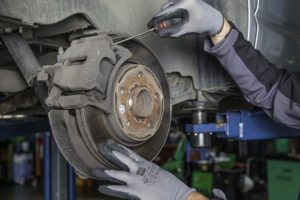Week 1- Vehicle Inspections


The roads can be an extremely dangerous place. According to the National Safety Council, an estimated 42,000 people died in motor vehicle crashes in 2020. While many accidents are caused by distracted driving and driving under the influence, mechanical issues also lead to accidents. Vehicle inspections and preventative maintenance are effective ways to prevent mechanical issue-related crashes.
Mechanical Issue-Related Crashes
Only a few types of mechanical issues represented the majority of accidents that were caused by some type of failure in a vehicle. The National Highway Transportation Safety Administration reported that tire/ wheel degradation or failure represented 43% of all mechanical issues resulting in crashes. Brake degradation or failure was second at 21%, and steering/suspension/ transmission failure represented 10.5% of mechanical issues that lead to accidents. It is important to inspect your vehicle for these common issues.
Vehicle Inspections
Most states require an annual in-depth inspection of any vehicle registered in that state to help avoid these types of problems creating a hazard on the road. It is important to also complete more frequent inspections of your vehicle prior to use. A simple walk around of your car or truck prior to operation can prevent an accident. A few things to look for during a quick inspection:
- Look for low tire pressure. This could signal that you need air in the tire or a patch, depending on the problem.
- Look for any bubbles in your tire. If there is a bubble in your tire it means you have a break in a belt in the tire, and it is now compromised. It is recommended that you use your spare or get it replaced immediately before driving the vehicle again because the tire could give way at any time.
- Start the car and listen for any odd noises.
- Make sure there are no objects that you could strike pulling out from where you are parked.
- Pull forward and test the brakes before starting your trip.
Summary
While the majority of the time you will never have any of the issues mentioned above, the one time you do, it could result in a serious accident. Take mechanical issues seriously, and when you find one during an inspection, get it fixed by a professional to ensure the vehicle is safe to operate.
Week 2- Opioid Abuse


It is no secret that opioid abuse in the United States is an epidemic. While these drugs have been a problem for years, there has now been a recent national spotlight on the issue. It is important to understand how common this issue is, the side effects of abuse, and how abuse can affect an entire workplace.
Opioid Abuse Statistics
- More than 49,800 people died from opioid overdoses in 2019 in the US, according to drugabuse.gov.
- A recent article published by Forbes featured interviews with construction company owners and developers, and they stated, “there is a problem in the construction industry, and it has made reliable labor an unattainable commodity across the country.”
Opioid Abuse Effects
The side effects of opioid abuse are fairly varied and may include:
(source: www.drugabuse.com)
- Drowsiness
- Lethargy
- Paranoia
- Respiratory depression
- Nausea
It is easy to imagine how opioid abuse and the side effects it brings could have negative effects on the work of those who suffer from addiction. Moreover, not only is the person who is under the influence of the drugs at an increased risk for injury or death while at work, but everyone around the worker is as well.
Image the increased risk for injury and death that is present if a single crane operator is under the influence of these drugs. Now, what if 100 workers are under the influence of opioids on a 2,000-person construction site? With today’s prevalence of abuse of these drugs, this scenario could be a reality if steps are not taken to screen workers prior to employment and report issues as they arise.
Summary
If you are battling substance abuse issues, whether it is opioids or another drug, seek help. There are many programs out there that can help with addiction. Many of these programs are often offered by your employer, union, or public organizations within the community. If you suspect a coworker is suffering from an addiction problem, speak with a supervisor. Opioid abuse is not just their problem when it carries over into the workplace. The side effects these drugs bring with their use can create dangerous situations where many people could be injured or killed on the job.
Week 3- Bees and Wasps


Almost everyone has experienced some type of bee or wasp sting in their life. Stings from these insects do not pose a major issue for most people. However, for others, there can be a severe allergic reaction that is life-threatening. Even if you have not experienced a severe allergic reaction to stings before, it is possible to have a severe reaction at any point in your life. It is important to avoid bees and wasps as well as to be able to recognize when someone is suffering from a severe allergic reaction from an insect sting.
Bee and Insect Sting Facts
According to NIOSH, thousands of people are stung by insects each year, and as many as 90–100 people in the United States die as a result of allergic reactions. This number may be underreported as deaths may be mistakenly diagnosed as heart attacks or sunstrokes or may be attributed to other causes. Most individuals only experience minor swelling and pain after being stung, but many individuals can experience other symptoms after a sting. Insect stings can result in any of the following symptoms:
- Pain
- Redness
- Swelling (in the area of sting and sometimes beyond)
- Flushing
- Hives
- Itching
- Anaphylaxis
Sting Prevention
Before performing any work in an area, it is important to do a site walk to look for any hazards, including bees and wasps. Oftentimes, people start performing a task not knowing there is an active hive in close proximity to them. Avoiding areas where bees or wasps are is the most effective way to prevent stings. If you are severely allergic to bees or wasps, avoid any work that puts you at great risk of getting stung. Wear clothing that covers as much skin as possible when working in areas where there may be bees and wasps. It is harder for stinging insects to sting through clothing.
If Stung-If a person has a history of severe reactions to stings, call 911 immediately. If the person is showing signs of a severe reaction or cannot breathe, have them inject their epinephrine as directed by their doctor For individuals who are not severely allergic then, contact your supervisor and conduct first aid measures as you have been trained.
Summary
Take the hazards that bees and wasps create seriously when working outdoors. Even if you are not allergic to them, someone close by may be. Do a site check before entering an area to perform work. Avoiding areas where these insects are is your best option to prevent stings. When avoiding them completely is not an option, and there is a nest in the area, try not to disturb it. If contact cannot be avoided, have them removed to another location by a professional or have them killed (if that is the only option) to protect yourself and others from stings. Always have an EPI pen nearby if you or a coworker is severely allergic to insect stings.
Week 4- SORT

There is an endless amount of acronyms when talking about safety. The acronym S.O.R.T. is a tool that can help remind us to take steps to address hazards and create a safe work environment. S.O.R.T stands for Stop, Observe, Recognize, and Take Ownership.
- Stop- It is necessary to take time not only at the beginning of the work shift to evaluate both the work area and equipment for hazards but also as conditions change. When we are rushed, we miss the small details that matter. Always take the time before a task begins to evaluate the work task you are about to do. Anytime conditions change, or things are not going as planned, stop work and evaluate what needs to be done to correct the situation.
- Observe- Take time to evaluate the environment around you. How are the weather conditions, lighting, and temperature at the work area? Are the needed personnel and tools in the work area ready to go? Has all equipment been thoroughly inspected prior to starting the work task? Has all necessary paperwork, such as SOPs, JSAs, or permits, been reviewed and completed?
- Recognize- Once you have stopped and observed the work area, what hazards do you see? Your ability to recognize hazards comes down to utilizing training, safety meetings, company policies, lessons learned, safety shares, and past experiences. Much time is spent discussing and training everyone onsite to be able to recognize hazards in order to mitigate them and protect ourselves from injury.
- Take Ownership- Ownership is the most important part of the process. Once you recognize hazards or potential issues while on the job, own them. See through that they get properly corrected in a timely manner. It is easy to just walk past an issue and think that it is not your problem. In reality, any hazard on the job is your problem. If someone else is hurt or there is property damage due to the hazard you recognized and walked past, it will have some sort of effect on you. Incidents affect a jobsite as a whole, and depending on the severity, can have far-reaching consequences for an entire company. There is also guilt you could feel due to an injury occurring to a coworker from a hazard you could have addressed. Taking ownership means more than just communicating the hazard to the other people in the work area. Stop work if necessary and get the right people involved to address the hazard correctly.
Summary
While these four steps are very basic, it is easy to skip some of them and just go through the motions due to complacency or time restrictions when at work. We often complete many of the same work tasks in the same way every day. This makes it easy to fall into a trap of having blinders on to hazards that could lead to an injury. Use the S.O.R.T. tool to remind yourself to take the time to really evaluate your work area for hazards and to take ownership of them.
